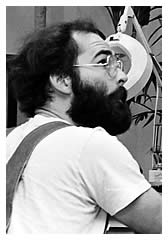
Barry Stilwell was Jefferson Productions' film editor at the Pressley Road studio in the late '70s. His fine work at JP led to an editor's job at a leading New York City editorial house.


Barry Stilwell was Jefferson Productions' film editor at the Pressley Road studio in the late '70s. His fine work at JP led to an editor's job at a leading New York City editorial house.

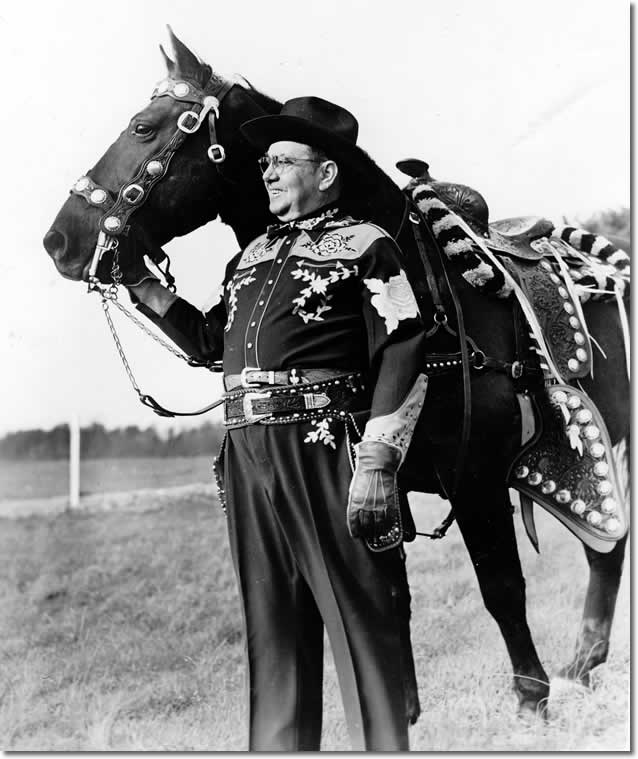
If you live long enough, you will get old, with the probable additional consequence of your becoming fat and needing glasses—even if in the Thirties and Forties you were one of the biggest stars in the movies.
Ladies and gentlemen . . . Gene Autry.
Editor's note: Well, it's beginning to look like Mr. KnowItAll doesn't know it all, at all. We've received this comeuppance from someone who knows what's what, and we apologize profusely for the error.
"Just wanted to let you know there is a mistake on this page. The picture is not Gene Autry but L.A. Love, Sr. (my grandfather). He was founder of Queen City Coach Co, later known as Queen City Trailways, in Charlotte, and often rode horses in the Charlotte Carousel Thanksgiving Parade as well as other events. He owned a cattle and horse farm on Central Ave in the 50's and 60's. He was largely responsible for getting the Union Bus Terminal in Charlotte built.
"In the early years of the Carousel Parade, Belks, Iveys, and Queen City Coach Co parade floats were always the best - competing with each other for the honor of Best Entry."
— Reid Love
From the Hank Warren Collection, courtesy Roy Warren
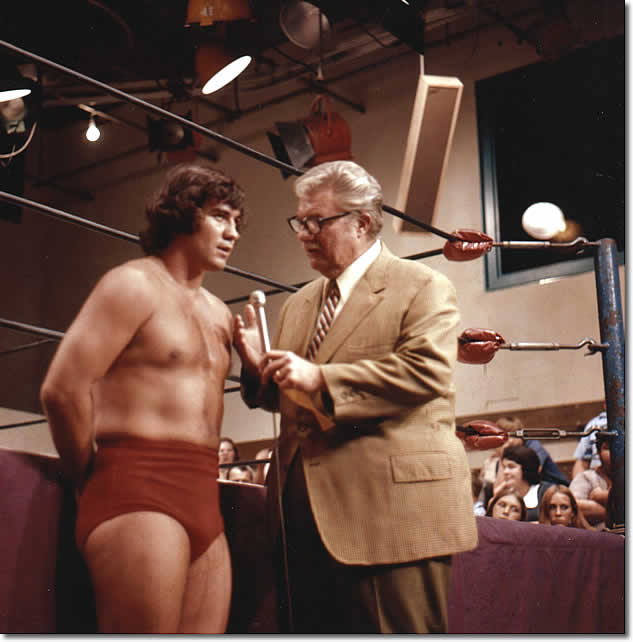
Dick Bourne of midatlanticgateway.com shared with us this impressive photo of Big Bill Ward with wrestler Jerry Brisco, and, on his Web site, he's published an interview with Mark de Castrique, formerly of WBTV. Here's a slice of that interview.
Mark de Castrique: I was one of the staff directors who regularly directed the Wednesday night tapings from June 1970 to December 1972. It was a lot of fun. "High drama."
Gateway: Do you remember in which specific studio you taped wrestling?
Mark: Championship Wrestling was taped in the large studio #2. The ring was set up by Crockett's people on Wednesday afternoon supervised by an old retired wrestler named Wally (Dusek) and we taped in the evening.
Gateway: Realizing this was 40 years ago, do the names of any of the wrestlers from those years stick out in your mind? Any particular memories about any of the wrestlers or things that happened during the tapings?
Mark: Some of the wrestlers on the shows I directed were also ones I had watched on Channel 3 as a kid. Rip (The Profile) Hawk & Swede Hanson, Johnny Weaver, The Great Bolo, Jerry Brisco, The Kentuckians, Haystack Calhoun, Homer O'Dell and his tag-team. Abe Jacobs and his patented Kiwi roll. You remember most wrestlers had their signature hold that guaranteed victory if they could just apply it.
Gateway: What are your memories of "Big" Bill Ward? Did you work with him on any other shows?
Mark: I only worked with Big Bill Ward on wrestling. He was easy to get along with and I remember his stock "action" phrases. "They're fighting like gladiators of old." "It's a Pier Sixer" (whatever that meant). "He's lower than the belly of a snake at the bottom of the Mariana Trench" (or bottom of the ocean). Usually used in reference to the evil manager Homer O'Dell. And, of course, Big Bill's signature sign off - "Hello to all the shut-ins" and "Be good sports wherever you go!"
Go to this Gateway page for the full interview, and here for more WBTV wrestling photos.
Mark, who resides in Charlotte, is a prolific writer of popular mysteries. See his page on Amazon.com.
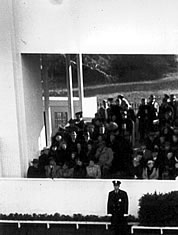 |
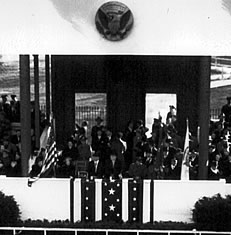 |
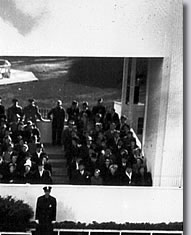 |
|
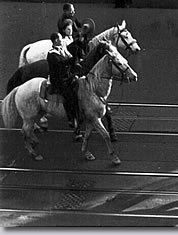 |
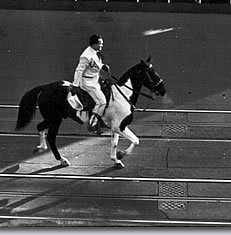 |
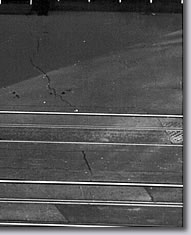 |
This is one of them. Fred Kirby is riding the original Calico in the Inaugural Parade for the 33rd president of the United States, Harry S Truman. Washington, D. C., January 20, 1949.
Courtesy Dianne Kirby Robinson.
 |
 |
 |
 |
 |
 |
Producer (with great anguish): "Look, these twelve actors are about to miss the last plane back to New York. We'll have to pay for another night at the Radisson, two more meals each and their talent fees plus penalties for another day. We were already over budget at eight o'clock this morning. My God, man, you're about to drive us into bankruptcy."
Director (lost in concentration): "We need one more take. It won't take but a minute."
Producer fumes. (Guess which man in the photo is the producer.)
One of the best-kept secrets at Jefferson-Pilot Broadcasting was a little shop of horrors out on Pressley Road in the '70s and '80s called Jefferson Films. Out of sight, out of mind. It was an adjunct to the mother ship, Jefferson Productions (which specialized in videotape production). Our little operation produced commercials, mostly, all in the time-honored medium of film, in sizes 16 and 35mm. We did good work.
For the first six years on Pressley, Reno Bailey was the film "czar" (preferring that modest designation over his official but professionally sucky title, "Film Production Supervisor"). Bob Newcomb (son of Alan) was our highly talented and well regarded Director-Cameraman. Others in our little band will be revealed in another article.
In this photo worth a thousand words, Bob is shooting with our Eclair NPR 16mm sound camera with a 400-foot magazine loaded with Eastman 7247 color negative, using an Angenieux 12-120 zoom lens, all supported by an O'Connor fluid camera head, atop our indestructible, heavier-than-a-Sherman tank Moviola crab dolly. In the background are a couple of Mole-Richardson 5-K's with barn doors. Oh, the memories.
 |
 |
 |
 |
 |
 |
Hank Warren was not exactly the leader of the band, but close enough. Not long before Hank died, Jim Scancarelli ran into him at a doctor's office. They chatted about old times, and Jim took this picture. Which thousand words is this worth? What does it show us? A man content with his life and his memories, satisfied that he had a million friends and not one enemy. A man happy to have been able to act out his dream of being an entertainer, and fortunate to have worked so long in another field he loved, photography.
That old spark of humor was still there. He couldn't resist the chance to cut up, as shown in this sequence where he weighs himself, then feigns shock at the scale's bad news. This was all Hank's idea. He staged the whole thing, directing Jim when to take the shots.
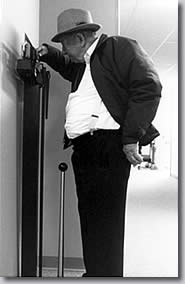 |
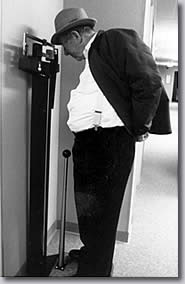 |
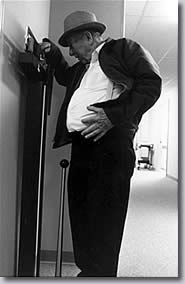 |
Photos by Jim Scancarelli
 |
 |
 |
 |
 |
It was the flagship of the RCA fleet, built from old locomotive parts, requiring two engineers, a fireman, a brakeman and a conductor. It seated six. They should have dubbed it the "Orca" for it was big as a whale. It would take all day to test the tubes in that monster. But it was cutting edge technology for its time. Nowadays, a better camera can fit in your shirt pocket, and you may even have two of them. Don McDaniel, who used to horse this big old thing around on a daily basis, remembers they had to turn on every light in the studio to get a decent picture.
Mr. Crutchfield (left), who was determined that we be the first and the best, was proud as punch the day it arrived. The man fiddling with the lens is Tom Howard, vice president in charge of engineering. Notice that both men are engaged in an activity no longer permitted in most corporate environs: smoking cigarettes.
Photo courtesy Jim Scancarelli
 |
 |
 |
 |
 |
 |
 |
||
Jefferson-Pilot Broadcasting was a planning company. There were countless meetings, retreats, sessions, conclaves and conferences. Want to know how many paper clips the company will buy five years out? Just look on page 867 of the current Strategic Plan. An exaggeration, of course, but the Crutchfield (and later Jorgenson) administration lived by The Plan.
This photo, taken about 1960, shows the management team at a pool-side meeting at Mr. Crutchfield's home. Note the symbolic ceramic rooster atop the pool house, crowing silently in tribute to 4XD's humble beginnings in a chicken house.
In these blowups, point to the individual's face for his identity.
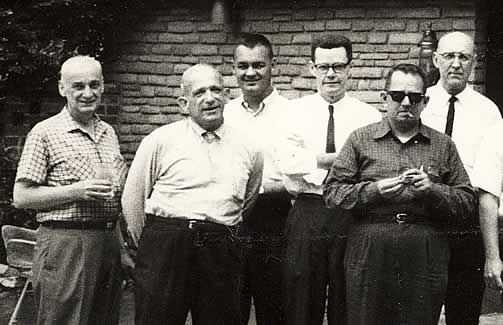
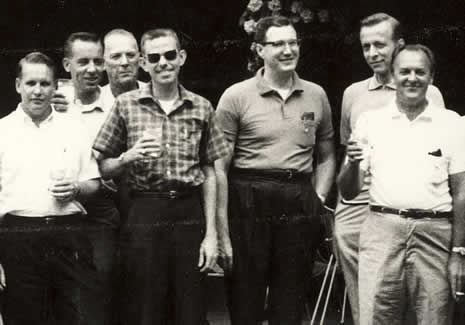
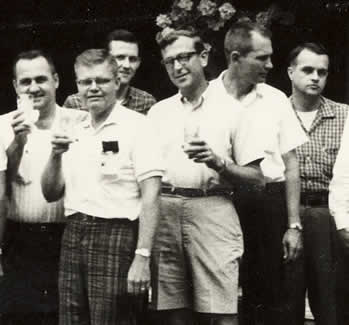
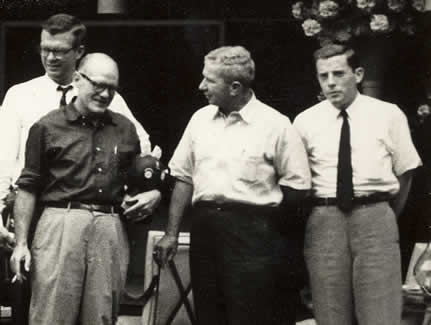
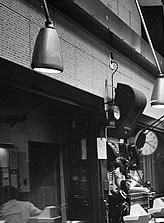 |
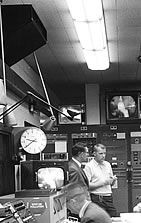 |
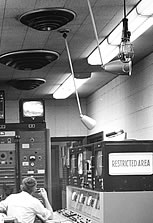 |
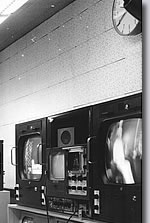 |
|
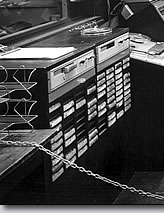 |
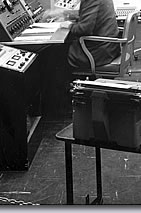 |
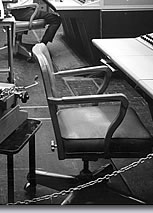 |
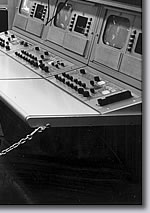 |
The spirits that resided within those old walls included Garry Moore, Arthur Godfrey, John Glenn, Dwight D. Eisenhower, Mike Douglas, Matt Dillon, Lyndon Johnson, Pat Lee, Lucy Ricardo, Arthur Smith, Eric Severeid, Captain Kangaroo, Betty Feezor, Lee Harvey Oswald, Ed Sullivan, AlFred Hitchcock, Elvis, Betty Furness, Alan Newcomb, Walter Cronkite...and countless others.
After signoff, in the spooky darkness, they would all come out and play, interrupted only by Mr. Vandiver, or some other night watchman, as he made his rounds.
Consider Andy Anderson (shown in foreground) and all the others who sat in this chair for eight hours every day, day after day, year after year, absorbing the coverage of great events, the hundreds of shows and the tens of thousands of commercials. How did they block this kaleidoscope of sights and sounds from their dreams? How many times did they tense up at this: "We interrupt this broadcast to bring you a special news bulletin..."
What was a master control engineer called, and what were his duties? We asked Bill Napier, head of engineering at Channel 3 from the mid '80s until 1999:
"The Master Control Engineer was called 'The Master Control Engineer.' Their duties varied depending on the regime, but in general they did the actual on-air switching between programs, commercials and network. Their 'switcher' was the last one in the line to the microwave that sent the signal to Spencer Mountain. They had 'the final say' before the signal was sent to the 'the Mountain.'' (Can’t you hear George Reynolds saying that?)
"They kept the log and signed on and off that log. They 'shaded' – adjusted video – on the film chain and VTR cameras, and sometimes the studio cameras as well. They 'rode level' on audio and had the final knob for that too.
"They had 'authority' over all other people’s decisions because they had their finger on 'The Button.'
"They all had First Class FCC Radiotelephone Licenses - the 'union card' that kept mere mortals out of engineering. That was a hard test back when they all got it. Yeah, I had one, but I think the test got easier in the 60’s.
"This picture looks like it was taken after the 'first rebuild.' The control consoles were part of the 1960s RCA 'New Look' for all the equipment. Powder Blue and Silver as opposed to the darker 1950s black and white equipment and racks. It appears the controls on the right side of the picture are for two groups of 3 RCA TK-42 'New Look' color cameras. (Worst camera ever built in any century. It was designed by a committee of 'suits' in Camden, NJ to go head-to-head with the new Plumbicon PC-60 (not 70) cameras. Made terrible pictures.)
In addition to Futrel "Andy" Anderson, other master control engineers from the 1950s to the '90s were Wade Lawrence, Sonny Howell, Bob Davis, Jud Gregory and Jack Waynick. In the photo's background, from left: Clif Livingston, Gil Caldwell and Lee Jenkins.
Photo contributed by Debbie Reynolds Reavis
 |
|
 |
|
 |
|
 |
|
 |
In the mid-sixties when the Company built a new wing to house Jefferson Productions, there came the day when the new videotape recorders arrived. Since they would not fit in the building's only elevator, the only means of getting them to the second floor was to poke them through a window with some sort of fork lift. A biiiig forklift. That's John Dillon, JP's general manager, looking nervously down from the office of his secretary, Barbara Wilson. On the ground, facing the camera, is Jay Torrence. In the dark suit, observing the operation in his usual calm manner, is Frank Bateman, head of WBTV Engineering. Each of these babies cost about a quarter million dollars, so we wouldn't want to drop one.
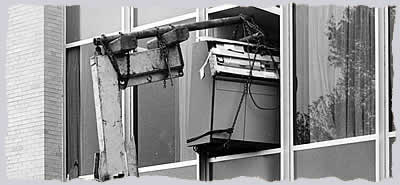 It all worked out well, as usual, and the recorders went on to capture thousands of hours of programs and commercials.
It all worked out well, as usual, and the recorders went on to capture thousands of hours of programs and commercials.
Photos courtesy Ken Helms.
 |
|
 |
|
 |
|
 |
|
 |
|
 |
Find the nearest location where the ground is soft, and lay that puppy in the ground. The only alternative was to wake up an engineer, if possible, and suggest he take a look at it. But that could take all day.
Another option was to ship it back to the Norelco factory, where its components would be smashed to bits and used to make electric shavers.
In this scene, we see director Gene Birke administering last rites, Virgil Torrance filling the grave, and, in the background Ken Furr approaching to read a poem from Sonny's Scrapbook.
We're kidding. They're on location—probably taping an episode of the Arthur Smith Show—and preparing for a low-angle shot of someone, perhaps Maggie Griffin, walking along the beach lip-synching the words to some popular ballad of the day, like "Girl From Ipanema"—or "Rocky Top."
It wasn't easy horsing all that equipment around. As you'll see in the Jefferson Productions gallery, it seemed the camera and lights always had to be placed in the most difficult-to-reach places.
Photo courtesy Jim Rogers.
Don McDaniel writes: Just a small correction in your very funny description of burying the camera. This was in fact a remote shoot at Santee Cooper with the Arthur Smith gang. But, that is not Gene Birke in front. Don't know who that is. I was the director on that shoot. You're exactly right as to why you would bury a camera. As you are well aware, back in those days the only cameras we had to work with were big and that was one of the ways to get a low angle shot. It was Maggie walking on the beach lip syncing a song.
On that shoot we also had Arthur standing on water playing "Muddy Waters" on the guitar.
I found and old heavy duty BBQ grill with legs on it and put it just under the surface of the water and had Arthur stand on it. It took a little persuading to get him to do that.
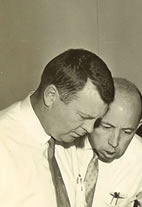 |
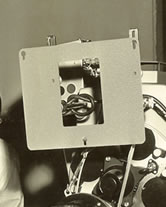 |
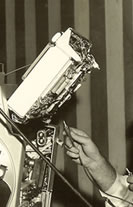 |
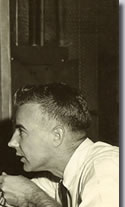 |
|
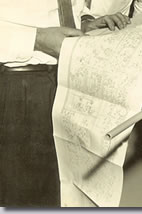 |
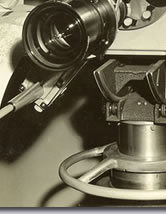 |
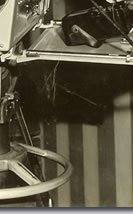 |
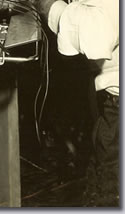 |
When something went awry, WBTV's crack team of engineers would spring into action. On the right, Paul Townsend tentatively applies a rectal thermometer, hoping to detect a pulse. Meanwhile Bryan Yandle, left, and Bob Dycus consult a city map for the location of South-21 TV Camera Repair.
Our thanks to Bryan's daughter, Leah Yandle Helms, for this great photo.
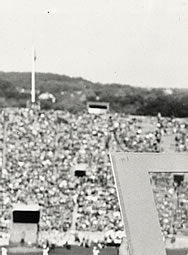 |
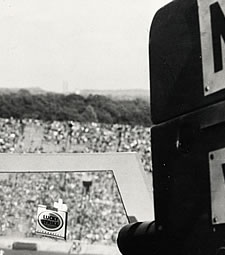 |
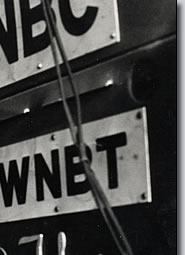 |
|
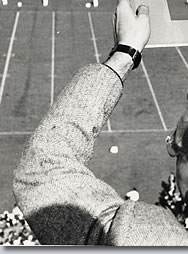 |
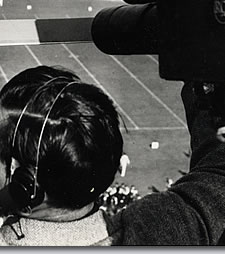 |
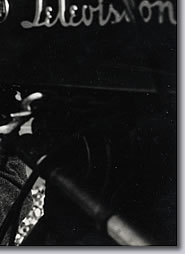 |
In the early fifties, special effects on live TV were nonexistent.
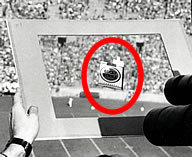 In the photo, a pack of Luckies was glued to a piece of clear glass and held in front of the lens, so the sponsor's product could be shown over a live shot. Here's hoping the man had a steady hand.
In the photo, a pack of Luckies was glued to a piece of clear glass and held in front of the lens, so the sponsor's product could be shown over a live shot. Here's hoping the man had a steady hand.
Practical methods for doing things were dreamed up by the very early producers, like Don Hewitt of CBS, one of the most innovative, whose ideas led to titles being superimposed over video, development of the Tele-Prompter, and other procedures and inventions used routinely today.
Who knows how many techniques were developed by local production people whose needs required their ingenuity.
Photo courtesy Jim Scancarelli.